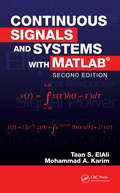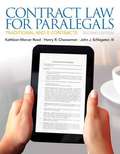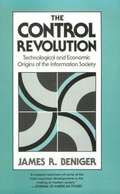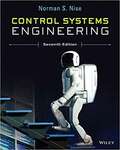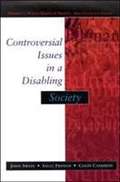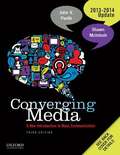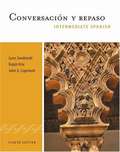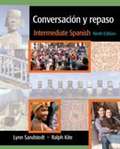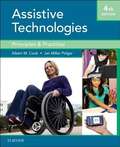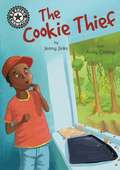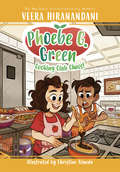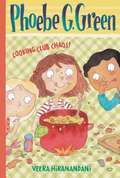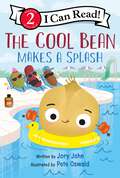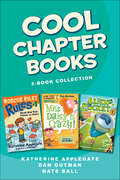- Table View
- List View
Continuity and Change, [Grade 3], Inquiry Journal
by James Banks Kevin P. Colleary William DeverellNIMAC-sourced textbook
Continuity and Change, [Grade 3], Research Companion
by Kevin Colleary James Banks William DeverellNIMAC-sourced textbook
Continuous Signals and Systems with MATLAB (Electrical Engineering Textbook Series)
by Taan S. ElAli Mohammad A. KarimDesigned for a one-semester undergraduate course in continuous linear systems, Continuous Signals and Systems with MATLAB, Second Edition presents the tools required to design, analyze, and simulate dynamic systems. It thoroughly describes the process of the linearization of nonlinear systems, using MATLAB to solve most examples and problems. With updates and revisions throughout, this edition focuses more on state-space methods, block diagrams, and complete analog filter design.
Contract Law for Paralegals: Traditional and e-Contracts (Second Edition)
by Kathleen Mercer Reed Henry R. Cheeseman John J. SchlageterThe book intends to provide students with a strong foundation in the essential principles of contracts and to ensure their familiarity with and recognition of issues that arise in the area of contracts.
The Control Revolution: Technological and Economic Origins of the Information Society
by James R. BenigerWhy do we find ourselves living in an Information Society? How did the collection, processing, and communication of information come to play an increasingly important role in advanced industrial countries relative to the roles of matter and energy? And why is this change recent―or is it? <P><P>James Beniger traces the origin of the Information Society to major economic and business crises of the past century. In the United States, applications of steam power in the early 1800s brought a dramatic rise in the speed, volume, and complexity of industrial processes, making them difficult to control. Scores of problems arose: fatal train wrecks, misplacement of freight cars for months at a time, loss of shipments, inability to maintain high rates of inventory turnover. Inevitably the Industrial Revolution, with its ballooning use of energy to drive material processes, required a corresponding growth in the exploitation of information: the Control Revolution. <P><P>Between the 1840s and the 1920s came most of the important information-processing and communication technologies still in use today: telegraphy, modern bureaucracy, rotary power printing, the postage stamp, paper money, typewriter, telephone, punch-card processing, motion pictures, radio, and television. Beniger shows that more recent developments in microprocessors, computers, and telecommunications are only a smooth continuation of this Control Revolution. Along the way he touches on many fascinating topics: why breakfast was invented, how trademarks came to be worth more than the companies that own them, why some employees wear uniforms, and whether time zones will always be necessary. <P><P>The book is impressive not only for the breadth of its scholarship but also for the subtlety and force of its argument. It will be welcomed by sociologists, economists, historians of science and technology, and all curious in general.
Control Systems Engineering
by Norman S. NiseControl Systems Engineering, 7th Edition has become the top selling text for this course. It takes a practical approach, presenting clear and complete explanations. Real world examples demonstrate the analysis and design process, while helpful skill assessment exercises, numerous in-chapter examples, review questions and problems reinforce key concepts. A new progressive problem, a solar energy parabolic trough collector, is featured at the end of each chapter. This edition also includes Hardware Interface Laboratory experiments for use on the MyDAQ platform from National Instruments. A tutorial for MyDAQ is included as Appendix D.
Controversial Issues in a Disabling Society
by John Swain Sally French Colin CameronAt its best, Disability Studies is an arena of critical debate, addressing controversial issues concerning not just the meaning of disability, but the nature of society, dominant values, quality of life, and even the right to live.
Convention on the Rights of Persons with Disabilities and Optional Protocal (CRPD-2006) -Nepal
by National Federation of the Disabled Nepalको नेपाली संस्करण अपाङ्गता अधिकार र विकासका लागि कृयाशील नेपाल (ADRAD Nepal) ले पहुँचयोग्य ढाँचामा तयार गरेको हो ।
Convention on the Rights of Persons with Disabilities CRPD Myanmar
by Government MyanmarThe ratification of the Convention on the Rights of Persons with Disabilities (CRPD) by Myanmar on 7 December 2011 brings a total of 108 States Parties to the CRPD, while the Optional Protocol (OP) has 63 ratifications.
Converging Media: A New Introduction to Mass Communication
by John V. Pavlik Shawn McintoshDigital media is changing the ways in which we communicate: we watch TV and movies online, call friends on computers, and read newspapers on cell phones. Placing convergence at the center of the discussion, Converging Media: A New Introduction to Mass Communication uses the technologies we employ everyday to explain our current media environment - and to project where we might be headed. Rather than discussing each media industry in isolation, Converging Media shows how each branch of media (print, visual, and audio) relates to and influences the others. This enables students to see the inextricable and dynamic relationship between converging media and traditional media formats.
Conversacion y Repaso: Intermediate Spanish (8th edition)
by Lynn A. Sandstedt Ralph Kite John G. CopelandCONVERSACIoN Y REPASO, Eighth Edition, is the core text of the Intermediate Spanish Series that has gained the reputation as the most complete grammar syllabus with in-depth explanations, while its three book format allows greater flexibility for any intermediate Spanish program.
Conversación y repaso: Intermediate Spanish
by Lynn Sandstedt Ralph KiteCONVERSACI & ÓN Y REPASO, Ninth Edition, is part of a three-volume INTERMEDIATE SPANISH series that gives you a thorough review of grammatical structures and helps you communicate with confidence in Spanish. You'll find clear, easy-to-understand explanations of grammar topics in plain English that you can follow on your own. You'll quickly learn to use and develop reading, writing, speaking, and listening skills through a variety of activities and exercises for conversation. Plus, the book's many study resources, including Heinle iRadio's MP3-ready, Spanish-language tutorials for pronunciation and grammar, will help you succeed in the course!
Conversacion y Repaso Intermediate Spanish (8th edition)
by Lynn A. Sandstedt John G. Copeland Ralph KiteCONVERSACIN Y REPASO, is part of a three-volume INTERMEDIATE SPANISH series that gives you a thorough review of grammatical structures and helps you communicate with confidence in Spanish. You'll find clear, easy-to-understand explanations of grammar topics in plain English that you can follow on your own. You'll quickly learn to use and develop reading, writing, speaking, and listening skills through a variety of activities and exercises for conversation. Plus, the book's many study resources, including Heinle iRadio's MP3-ready, Spanish-language tutorials for pronunciation and grammar, will help you succeed in the course!
Cook and Hussey's Assistive Technologies: Principles and Practice (Third Edition)
by Albert M. Cook Janice Miller PolgarMaster the assistive strategies you need to make confident clinical decisions and help improve the quality of life for people with disabilities with the latest edition of this comprehensive text. Based on the Human Activity Assistive Technology (HAAT) model developed by the authors, the book provides detailed coverage of the broad range of devices, services, and practices that comprise assistive technology and focuses on the relationship between the human user and the assisted activity within specific contexts. This new edition has been expanded and updated, and features new multimedia components that further demonstrate how to apply the concepts you've learned to real-world practice. Focus on clinical application guides you in applying concepts to real-world situations. Human Activity Assistive Technology (HAAT) framework demonstrates assistive technology within common, everyday contexts for more relevant application. Review questions and chapter summaries in each chapter help you assess your understanding and identify areas where more study is needed. Assistive Technology for Cognitive Augmentation chapter gives you a foundation in the growing use of assistive technology to enhance human cognitive processes. Technologies that Aid Transportation familiarizes you with the many options of transportation assistance available and helps you determine which are right for your clients. Separate chapters on sensory aid for visual and auditory impairment provide additional strategies in these key assistive areas. Bound-in companion CD-ROM features videos of assessment and device use that helps you visualize procedures and reinforce your clinical application skills. Evolve resources test your understanding of terms and concepts and link you to supplemental sources for further research. Additional case studies throughout the text prepare you for practice with realistic client scenarios. Expanded evidence-based content supports concepts with real-world research data. Additional photographs, illustrations, tables, and boxes provide clear visual references and quick access to important information.
The Cookie (Fountas & Pinnell Classroom, Guided Reading Kindergarten)
by Stephen Krensky Giuliano FerriNIMAC-sourced textbook
The Cookie Thief: Independent Reading 11 (Reading Champion #504)
by Jenny JinksAmari has been baking cookies with his grandmother, but every time he leaves them to cool, they disappear! Who is the mysterious cookie thief? Amari is about to make a surprising discovery!Reading Champion offers independent reading books for children to practise and reinforce their developing reading skills.Fantastic, original stories are accompanied by engaging artwork and a reading activity. Each book has been carefully graded so that it can be matched to a child's reading ability, encouraging reading for pleasure.Independent Reading 11 stories are the perfect introduction to first chapter books for children aged 6+ who are reading at book band 11 in classroom reading lessons.
Cooking Club Chaos! #4 (Phoebe G. Green #4)
by Veera Hiranandani"Gently humorous black-and-white illustrations pair nicely with the text. With all the foodies out there, this delightful series deserves a long shelf life…and many more courses."--Kirkus Reviews"Fans of Junie B. Jones and Judy Moody . . . will enjoy this."--School Library Journal"Age-appropriate humor via an outspoken, lovable, take-charge narrator. Dreidemy’s wiggly spot illustrations, meanwhile, supply plenty of nervous energy."--Booklist Phoebe’s best friend Sage has the same lunch every day: a turkey sandwich, a cheese stick, and a bag of popcorn. Phoebe doesn’t understand why he won’t try new things, and is determined to convince him to. She and Camille come up with the perfect solution: a cooking club to show Sage how many exciting foods there are! But will it be enough to convince Sage? And will it spoil their friendship?
Cooking Club Chaos! #4
by Veera Hiranandani Joelle Dreidemy"Gently humorous black-and-white illustrations pair nicely with the text. With all the foodies out there, this delightful series deserves a long shelf life...and many more courses."--Kirkus Reviews"Fans of Junie B. Jones and Judy Moody . . . will enjoy this."--School Library Journal"Age-appropriate humor via an outspoken, lovable, take-charge narrator. Dreidemy's wiggly spot illustrations, meanwhile, supply plenty of nervous energy."--Booklist Phoebe's best friend Sage has the same lunch every day: a turkey sandwich, a cheese stick, and a bag of popcorn. Phoebe doesn't understand why he won't try new things, and is determined to convince him to. She and Camille come up with the perfect solution: a cooking club to show Sage how many exciting foods there are! But will it be enough to convince Sage? And will it spoil their friendship?
Cooking on the Grill (Fountas & Pinnell Classroom, Guided Reading Kindergarten)
by Liz Dana Susan SwanNIMAC-sourced textbook
The Cool Bean Makes a Splash (I Can Read Level 2)
by Jory JohnThe Cool Bean faces the super slide in this Level Two I Can Read by the #1 New York Times bestselling duo Jory John and Pete Oswald!It's a perfect day at the community pool for a swim. The cool beans are the best swimmers in town. Check out how they dive! Look at how they cannonball! Watch how they backflip! YOW!As for the Cool Bean, the shallow side of the pool is the only side of the pool he treads water on. Until one day, the Cool Bean sees the super slide and finds the courage to finally ride the slide...or does he? Find out in this splashy story about taking chances, trying new things, and leaning on your friends.The Cool Bean Makes a Splash is a Level Two I Can Read book, geared for kids who read on their own but still need a little help. Whether shared at home or in a classroom, the engaging stories, longer sentences, and language play of Level Two books are proven to help kids take their next steps toward reading success.
Cool Cats, Hot Dogs (Fountas & Pinnell Classroom, Guided Reading)
by Suzanne SladeNIMAC-sourced textbook
Cool Chapter Books 3-Book Collection
by Katherine Applegate Dan Gutman Nate BallThis collection is perfect for anyone looking to try out three bestselling series that are fun, easy-to-read, loaded with humor and art, and just right for young independent readers. In includes:Roscoe Riley Rules #1: Never Glue Your Friends to Chairs: If the kids can't sit still for the class performance, Roscoe's teacher could be in big trouble. Fortunately Roscoe has a plan to save her—a super, mega, gonzo plan! What could go wrong?My Weird School #1: Miss Daisy Is Crazy!: In this first book in the outrageously funny series that has reached millions of readers around the world, second-grade teacher Miss Daisy is in over her head. She doesn't even know how to add or subtract! But the kids have other things on their minds. Principal Klutz has promised that if they read a million pages in books, they can turn the school into a video-game arcade for one whole night!Alien in My Pocket #1: Blast Off!: When a four-inch-tall alien crash-lands through Zack McGee's bedroom window, Zack is sure he's about to become the first victim in a new War of the Worlds. But when the alien turns out to have weapons that are more ticklish than terrifying, Zack realizes that rather than protect the world from the alien it's up to him to protect the alien in his pocket from the world.

